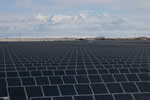
|
 |
Solar Photovoltaic Technologies
Utility-scale solar photovoltaic technologies convert energy from sunlight directly into electricity, using large arrays of solar panels.
Solar photovoltaic technologies convert solar energy into useful energy forms by directly absorbing solar photons—particles of light that act as individual units of energy—and either converting part of the energy to electricity (as in a photovoltaic (PV) cell) or storing part of the energy in a chemical reaction (as in the conversion of water to hydrogen and oxygen).
Solar Cells
Solar cells are devices that convert sunlight directly into electricity. Solar cells are made of layers of semiconductor materials similar to those used in computer chips. When sunlight is absorbed by these materials, the solar energy knocks electrons loose from their atoms, allowing the electrons to flow through the material to produce electricity. Additional basic information about solar photovoltaic technology is available through DOE's Office of Energy Efficiency & Renewable Energy website. |

Solar cell, module, and array.
Click to enlarge |
Solar Arrays
Solar cells are generally very small, and each one may only be capable of generating a few watts of electricity. They are typically combined into modules of about 40 cells; the modules are in turn assembled into PV arrays up to several meters on a side. These flat-plate PV arrays can be mounted at a fixed angle facing south, or they can be mounted on a tracking device that follows the sun, allowing them to capture more sunlight. For utility-scale electricity generating applications, hundreds of arrays are interconnected to form a single, large system. |

Solar arrays.
Click to enlarge |
Click a photo below to view interactive panoramas of PV facilities.

PV Facility - Interactive Panorama. Source: Argonne National Laboratory

Substation at a PV Facility - Interactive Panorama. Source: Argonne National Laboratory
Concentrated PV (CPV) Systems
Concentrated PV (CPV) systems concentrate sunlight on solar cells, greatly increasing the efficiency of the cells. The PV cells in a CPV system are built into concentrating collectors that use a lens or mirrors to focus the sunlight onto the cells. CPV systems must track the sun to keep the light focused on the PV cells. The primary advantages of CPV systems are high efficiency, low system cost, and low capital investment to facilitate rapid scale-up; the systems use less expensive semiconducting PV material to achieve a specified electrical output. Reliability, however, is an important technical challenge for this emerging technological approach; the systems generally require highly sophisticated tracking devices. |

CPV collector
Click to enlarge |
Concentrating Solar Power (CSP) Technologies
The Solar Energy Development PEIS will also consider environmental impacts associated with concentrating solar power (CSP) technologies; see the Concentrating Solar Power (CSP) Technologies page to learn more.
Additional Resources
The following documents are technical summaries of PV technologies prepared by the National Renewable Energy Laboratory.
|










